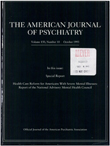12-month outcome of patients with major depression and comorbid psychiatric or medical illness (compound depression)
Abstract
OBJECTIVE: Inpatients with major depressive illness often have coexistent nonaffective psychiatric and/or medical conditions. The authors' objective is to address the following questions: 1) What is the effect of comorbid illness on the severity of major depression and associated psychosocial factors? 2) How does the course of depression differ for patients with and without concurrent illness? 3) Do patients with compound depression differ in rate of recovery and time to recovery from patients with pure depression? METHOD: The subjects were 78 patients with a DSM-III diagnosis of major depression who were consecutively admitted to an acute care university-affiliated psychiatric hospital; 37 of these patients had major depression only and 41 had major depression compounded by a coexisting axis I, II, or III condition. The patients were studied while hospitalized and for 12 months after hospital discharge. Instruments used included the Modified Hamilton Rating Scale for Depression, the Global Assessment Scale, and the Social Readjustment Rating Scale. RESULTS: Patients with compound depression reported significantly poorer functioning over the 12-month follow-up period and had lower recovery rates than the patients with pure depression. There were no differences in recovery rates between men and women with compound depression, but significantly more men than women with pure depression recovered. CONCLUSIONS: Compound depression is a common clinical occurrence, the course of illness is more difficult for patients with compound depression than for patients with pure depression, and the recovery rate of patients with compound depression is lower than that of patients with pure depression.
Access content
To read the fulltext, please use one of the options below to sign in or purchase access.- Personal login
- Institutional Login
- Sign in via OpenAthens
- Register for access
-
Please login/register if you wish to pair your device and check access availability.
Not a subscriber?
PsychiatryOnline subscription options offer access to the DSM-5 library, books, journals, CME, and patient resources. This all-in-one virtual library provides psychiatrists and mental health professionals with key resources for diagnosis, treatment, research, and professional development.
Need more help? PsychiatryOnline Customer Service may be reached by emailing [email protected] or by calling 800-368-5777 (in the U.S.) or 703-907-7322 (outside the U.S.).



